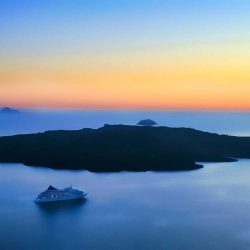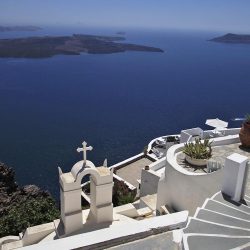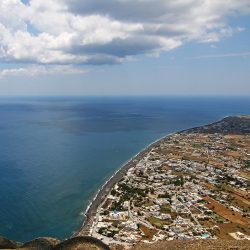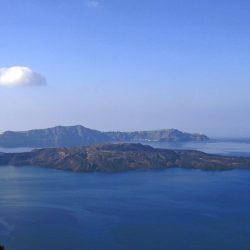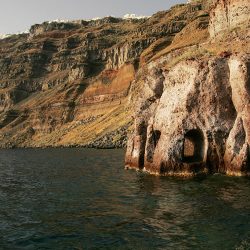Santorini (Thira) is the only Cycladic island with an active volcano and the only one that has settlements built not on sea level, but on the edge of the inner walls of the great crater formed by a volcanic eruption circa 1600 BC. It is also one of the last sites in the world where architectural complexes of underground rock-hewn houses survive inside the volcanic earth. The caldera walls are sheer cliffs, 150-350 m. tall. They contain rocks such as haematite, andesite and the volcanic soil called Theraic earth, in distinct layers formed by the eruptions of the volcano. The eastern side of the island slopes gently to the sea, lined with beaches of black volcanic sand.
THE VOLCANOES
Santorini is famous worldwide. Every year the volcanic island of the Aegean wins several international awards as one of the most popular romantic destinations and millions of people dream of visiting the caldera and the villages built on its rim! The island features a peculiar geomorphology. Volcanic activity in the area began 1.5 million years ago. Each eruption either destroyed the island or added new land to it. The one that took place in 1600 BC, during the economic and cultural pinnacle of the island, was named the «Minoan eruption». It caused the volcanic dome to collapse, forming the crater of the caldera. It destroyed not only the island’s great civilization, burying it under millions of tons of lava and ash, but probably the Minoan civilization as well. The two volcanic islets, Palaia (Old) and Nea (New) Kameni are in the center of the caldera and were formed later on: Palaia Kameni is dated back to 46-47 A.C. and Nea Kameni was “born” during 1570-1950, following a series of violent volcanic eruptions.
You can take a day trip to the volcanoes by boat from the ports of Athinios and Gialos (Old Port) right below Fira. You will have the chance to walk to the volcano crater -Nea Kameni- and enjoy the magnificent view of the caldera and the villages. Afterwards you will visit Palaia Kameni and the thermal springs. Soon after that, you will arrive at the island of Thirassia. In the afternoon the boats pass by the impressive caldera below Oia and you will enjoy spectacular views.
AKROTIRI
The archaeological site of Akrotiri is famous all over the world. Here the excavations that began in 1967 brought to light an impressive prehistoric settlement, one of the main urban centres of the Aegean. The growth of this town ended at the end of the 17th century BC, when its inhabitants left due to powerful seismic fore-shocks. Then, the volcano erupted and volcanic material covered the town and the rest of the island, preserving the buildings and their contents to this day. Many of the findings of Akrotiri are exhibited in the museum of Prehistoric Thera, in Fira. It is 15 km away from Fira. For information please contact: 30 22860 81939 and the Museum of Prehistoric Thira: 30 22860 23217.
THE VILLAGE. To get to the archaeological site you will have to pass through the Akrotiri village. It is worth visiting its fortress, which was built during the first Venetian century. It belogns to the same type of fortified settlements as Pyrgos and Emporio. At the Goulas of the castle you will find an interesting and well organized exhibition and workshop about the handmade Greek bagpipe (www.laponta.gr). Near Akrotiri village there is the lighthouse where you may enjoy a fantastic sunset.
ANCIENT THIRA
This historical city stands on Mesa Vouno, at an altitude of 396 m. It was founded in the 9th century BC by Dorian settlers, led by Thiras; habitation continued until the early Byzantine era. Excavations have mainly brought to light the areas built during the Hellenistic and Roman periods. Ancient Thira and the largest part of its cemeteries were excavated from 1895 to 1902. Routes are well-planned and marked with signs. In November 2000, an exquisite female statue of a Daedalic-style kore, dating back to 600 BC, was found in the cemetery.
THE CAVE HOUSES
The famous Santorini structures are hewn vertically into the volcanic soil. They are domed with no foundations, narrow-fronted and very deep. They are made of rocks (red or black) and Theran earth («aspa»), that keeps them cool in the summer and warm in the winter. Most of them were built by non-experts (vernacular or folk architecture); however, they turned out as artistic works characterized by harmony and simplicity. Elements like the insertion of accommodating spaces into each other, vaults and domes with a variety of shapes, free and irregular arrangement of public spaces, contribute to the uniqueness of the caldera villages.

